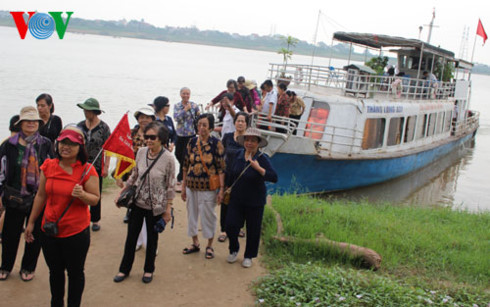The Red River, running through northern Vietnam, offers the chance to discover a rural way of life that has hardly changed for centuries. For those with one more day to spare in Hanoi, a cruise along the Red River is the perfect city escape. Pham Ha, CEO of Luxury Travel explores.

Cruising on the Red River has featured on the wish list of many of our team members for years. And so, we chartered a vessel with the Red River Tourism for a company incentive for 60 people, promising an escape from the bustling city of Hanoi.
Famous as the two largest and longest rivers in Vietnam, the Red River and the Mekong are both rich in mythology and history. Not only do they help the country feed itself but both have served the nation in its historical struggles for independence.
Each river has a story to tell and the Red River is no exception. Originating in China, the river flows past Hanoi and several provinces in the north of Vietnam before emptying into the Gulf of Tonkin.
Besides being one of the main river systems that plays a crucial role in irrigation and waterway traffic, the river is also seen as a symbol of the capital city. The Red River civilization is one of the 36 main civilizations of the world. It is the cradle of wet rice cultivation and of the typical village culture of northern Vietnam.
Led by our tour guide Thuy, whose name means ‘water’, we embarked on a cultural heritage discovery to experience the places, artifacts and activities that authentically represent the stories of people, past and present. We visited many famous places along the river, such as Dai Lo Goddess temple, Dam and Chu Dong Tu temples, before ending our tour at Bat Trang pottery village.
Our cruising journey started at 7:30am and finished at 4:30pm, including lunch on board. We spent a blissful and enlightening day sailing the waters, viewing ancient landscapes, temples and villages that have hardly changed over thousands of years. Along the way, Thuy told us the stories of the river and bridges.
First stop was a visit to Long Bien district’s Bo De pagoda and its orphanage, where we chatted with the chief monk Dam Lan and received his blessing, bringing us good luck for the journey.
Along the way, we enjoyed the fresh atmosphere and views of fields of sugarcane along the river banks. We saw beautiful old temples and enjoyed a walking tour through Bat Trang Ceramics Village, where we saw old houses, the Communal House and production areas as well as spending time wandering around the central market buying attractive ceramic products.
One of the most special sights we stopped at was Dai Lo and Dam Temples, where we were lucky enough to watch a ritual session dedicated to Mother Goddesses. At the typical Len Dong ceremony, a medium (diviner) pays respect to the four worlds: Sky, Earth, Water, and Forest. Spirits are invited to possess the female performer and bring to life some activities from the sacred world, to provide good health and prosperity to individual worshippers and communities. Participants believe they can communicate directly with the spirits who possess the medium.
These ritual “communications” are usually quite theatrical and follow some established conventions, but they can also relate to specific conditions in real life. Because this kind of worship is similar to the ancestral worship of the Vietnamese people, it reflects the respect of tradition, good social relations, the piety of the family and the sentiments between human beings.
The mother’s worship practice (tho mau) remains strong, especially in North Vietnam. It is a very popular belief in agricultural villages, where nearly 80% of the population works in rice cultivation. In these places, mystical worship remains commonplace, including the worship of new rice and trees, and the genies of houses and kitchens.
In Northern Vietnam, there are many famous pagodas which are sanctuaries dedicated to Mother Goddesses. The altars are normally located behind or at the side of the main pagoda, designed in harmony with the architecture of the main pagoda and the natural surrounding ambience.
Vietnamese people worship Mother Spirits in a separate temple called “Phu” in Vietnamese. The practice in Dai Lo temple relating to a belief in Mother Goddesses in the Three Realms was recognized as an intangible cultural heritage of humanity by UNESCO.
Our fascinating but all-too-brief tour also took in Da Hoa temple, where many precious relics are still preserved, and Chu Xa village, where we learned the legend of the village’s flourishing trade and resulting fame in years gone by, and how Princess Tien Dung taught the villagers wet rice cultivation and provided healthcare for local communities.
Temples were built in 72 communes to worship the princess and to this day an annual ritual is held in her honour on the 10th day of the second lunar month.
There are plans to make other cruise trips upstream to Duong Lam village in Son Tay town or towards Hoa Lu ancient citadel. However, though the river is rich in culture and history, the infrastructure is not yet good enough to welcome cruise tourism, with rubbish visible on the banks and the exploitation of sand leaving unsightly gaps in the banks.
Perhaps Hanoi could learn from neighbouring countries such as Bangkok, where river tourism is well developed. There is potential to connect Hanoi with other places such as Hoa Lu in Ninh Binh, Halong Bay or even the Highlands.
















